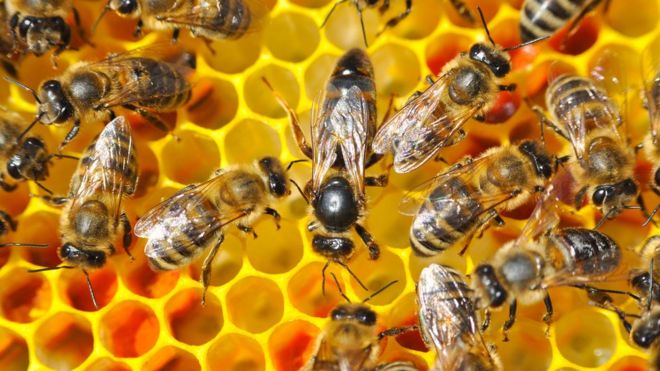- 4 January 2018
-
(여성) 여왕벌 증후군: 여성이 여성의 적인가?아름다운 인생/여성 2018. 1. 5. 19:25
출처: http://www.bbc.com/news/uk-41165076
Queen bees: Do women hinder the progress of other women? 여성이 여성의 적인가? (hinder: to limit the ability of someone to do something, or to limit the development of something:)
 GETTY IMAGES
GETTY IMAGES"Women leaders are role models and mentors to other women and girls."
That was the claim made in a recent Deloitte study looking at the number of women in leadership roles around the world.
But what if the opposite was true?
Instead of acting as mentors could successful female bosses be pulling up the ladder behind them because they perceive other women as a threat? (pulling up: 사다리처럼, 비스듬히 세워진 걸 끌어당겨 세우다.)
This is the theory known as queen bee syndrome.
First defined by psychologists at the University of Michigan in 1973, queen bee syndrome describes a woman in a position of authority in a male-dominated environment who treats subordinates more critically if they are female. **여왕벌 신드롬의 정의** 남성이 다수인 환경에서 높은 위치에 있는 여성이 자기 부하가 여성이면 남성부하보다 더 잘해주는 대신 오히려 남성보다 더 가혹하게 대하는 것임.
Prof Dame Sally Davies, England's first female chief medical officer, used the term in 2014 when describing her own experiences in the health sector.
"I saw it particularly in medicine - queen bees preening and enjoying being the only woman," she said. (preen: 몸치장하다. 우쭐대다)
Margaret Thatcher, the UK's first female prime minister, has been described as a queen bee for not promoting or furthering the careers of women in her cabinet. 대처는 영국 최초의 여성 수상이었지만 자신의 내각에 같은 여성을 각료로 기용하지 않았던 여왕벌임.
 GETTY IMAGES
GETTY IMAGESWas Margaret Thatcher a queen bee in a male dominated cabinet? In recent decades, there has been substantial increase in the number of women in work. But when it comes to rising to the top, women remain under-represented at board level. (substantial: 크기, 가치, 중요성에서 큰, 상당한) (uner-represent: 실제수량보다 적게 표시하다)
Deloitte's study looked at 7,000 companies in 44 countries and found women made up just 15% of corporate boards around the world.
In the UK progress is being made, albeit slowly. The number of FTSE 100 companies where women make up 33% of their boards increased from 19% to 28% in the past year.
So is queen bee behaviour hindering women's progress?
Opinion on the subject is divided.
Evolution
One recent study in the US argues the phenomenon does exist.
Prof Joyce Benenson, a psychologist based at Emmanuel College in the US, carried out an experiment in which volunteers were asked to split money with a fictitious same-sex partner.
The leader could keep as much or as little money as he or she wanted.
Prof Benenson found that the high status men were consistently more willing to reward their lower status colleagues than the high status women.
She says the findings are indicative of queen bee behaviour and that "women have a really hard time competing with other women".
- An A-Z of business beasts (bestiary of business terms: 비지니스 용어를 동물에 빗대어 설명. bestiary 중세의 동물우화집)
So why were the women less generous to other women?
Prof Benenson puts it down to evolution, saying women are not used to forming tight same-sex groups in the way that men are.
This goes back to a time, she says, when females had to compete for mates and for resources for their children.
Prof Benenson acknowledges that her research has been controversial.
When asked about the reaction from the academic community, she says: "Completely negative.
"It's hard for me but I try to be objective. I would like women to do better."
'I'm not like the other women'
While Prof Benenson believes women have evolved to behave in certain ways, other academics argue that queen bee behaviour - where it does exist - is actually a product of discrimination perpetuated by men.
Naomi Ellemers, a professor from Utrecht University in the Netherlands, has been researching gender inequality in the workplace for 20 years.
She says queen bee syndrome is an unhelpful label because the term suggests women are the problem.
"It's not a case of women hindering other women and men can't do anything about it," she says.
Prof Ellemers says queen bee behaviour is a response to sexism, where some women try to distance themselves from other women.
 ALAMY
ALAMYIs queen bee behaviour a consequence of sexism in the workplace? In 2011, Prof Ellemers and her colleagues carried out a study asking Dutch policewomen to recall specific experiences of being discriminated against.
They found that being reminded of gender discrimination prompted participants to downplay the sexism they had experienced.
It also triggered queen bee behaviour among policewomen who identified weakly with other women at work.
"They are being taught to be successful in the organisation you need to adopt male characteristics," Prof Ellemers says.
"They cope with gender bias by demonstrating they are different from other women."
These women use phrases such as: "I'm not like the other women, I'm much more ambitious."
Prof Ellemers calls this "self-group distancing" - a response that is also found among other groups that are under-represented at work - and argues queen bee syndrome is a product of gender stereotyping.
- Do women on boards increase company profits?
- BBC 100 Women 2017
- 'Why I invented the glass ceiling phrase'
Brenda Trenowden, head of financial institutions Europe at ANZ bank and the global chair of the 30% Club, a campaign seeking to increase the representation of women on boards around the world, dismisses queen bee syndrome entirely.
"It's a big red herring," she says. (herring: 청어) (red herring: 중요한 것에서 관심을 딴 데로 돌리는 것)
'Women dressed like the men'
Male-dominated companies, she says, need to recognise the leadership traits that women can bring, such as collaboration and empathy. (empathy: 감정이입, 공감)
The culture is changing but slowly, according to Ms Trenowden.
She says: "15 or 20 years ago women dressed like the men. I wore a woman's navy business suit, a white blouse and a red scarf because you needed to fit into the landscape.
"Women now wear dresses and bright colours; they've realised they don't need to be like men anymore."
 GETTY IMAGES
GETTY IMAGESResearch suggests it's harder for more than one woman to enter senior management In 2015, researchers at Columbia Business School and the University of Maryland's business school carried out a study of America's 1,500 biggest companies.
They wanted to know why women were under-represented in the top tiers of management. (tier: 단계, 층, one of layers/levels)
They discovered when a woman had been appointed as a chief executive, other women were more likely to be promoted to senior positions.
But when a company was headed by a man, it was much harder for more than one woman to make it into senior management.
The research found that the probability of a second woman becoming a senior manager fell by 51% when the chief executive was male.
The study argued an "implicit quota" was to blame. 비난할만한 데가 명확하지 않다.
It found that male-dominated leadership teams felt pressure to increase women's representation and would make an effort to have a small number of women in top management.
Losing its sting
Queen bee syndrome is a controversial subject.
The theory seeks to establish a cause and effect relationship between perceived female behaviour traits and the lack of representation at the top of management.
In doing so it makes sweeping generalisations about the way all women behave. (sweeping: 전면적인, 광범위한)
This is a very difficult link to prove. It also ignores the role that men may play.
The very existence of the term is perhaps one of many examples of sexism at work.
As Sheryl Sandberg, Facebook's chief operating officer, observed last year: "Women aren't any meaner to women than men are to one another. Women are just expected to be nicer". (meaner: mean의 비교급. 인색한, 못된)
Most research suggests that since the concept first gained traction in the 1970s, queen bee syndrome has lost its sting.
'아름다운 인생 > 여성' 카테고리의 다른 글
(여성) 전세계적으로 매일 여성 137명이 파트너나 가족에 의해 사망한다 (0) 2018.11.27 (여성/동영상) 사회통념에 도전하는 인도네시아 히잡 쓴 10대 헤비메탈 그룹 (0) 2018.03.19 (여성/미국) 美國에는 未成年者 新婦가 많다 (0) 2017.10.24 (여성) 여성전용칸 이용은 여성들에게 더 안전한가? (0) 2017.10.17 (여성) 남녀임금차이는 여성의 선택의 결과라고 美페미니스트그룹 인정 (0) 2017.09.25